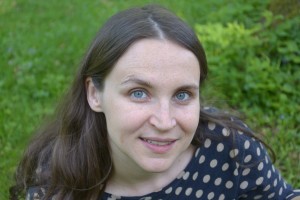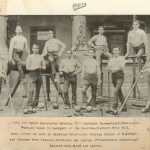Source: Stadtarchiv Mönchengladbach
Joe Pilates’ Childhood In Poverty – by historian Eva Rincke (Part 2)
“Perfecting the knee bend and many things to commend, his youth was gymnastic to the end.” – Joachim Ringelnatz, Setting up the Equipment (First Draft)
Alongside his secret outings into the woods, the only other thing Joseph Pilates enjoyed doing was gymnastics. Joseph’s father was an enthusiastic gymnast and took his son with him to the gymnastics club early on. Friedrich Pilates was a member of the Gladbach gymnastic club “Eintracht” and for many years was in charge of keeping the equipment in order. He succeeded in getting both of his sons, Joseph and the six year younger Friedrich, interested in gymnastics. At that time gymnastics was a blanket term for a variety of disciplines such as floor exercises and apparatus gymnastics. There were also additional exercises done “standing, walking, hopping, jumping, running and turning”, as well as exercises done “hanging, climbing, pull-ups and weight lifting […] rope walking and rope skipping, jumping over ditches, exercises on the flying carousel, marching, sprinting, duration running and running in a line, wrestling and other different games”.[i]
Joseph Pilates was devoted to gymnastics. When his father showed him a new exercise on the floor or the bars or the pommel horse he practiced the movement until he could do it without a mistake. He often accompanied his father when he went to adult practice. The lank boy admired the men’s muscular bodies and dreamed of being strong himself.
“To allow conscious effort to be at work together with aesthetic movement, so that the gymnast is filled with spirit” was one of the demands of the Swiss gymnastic legend Adolf Spieß.[ii] Doing individual exercises mindfully, that is using both body and mind equally, was something that Joseph Pilates learned as a boy. When a gym leader demonstrated a new exercise Joseph Pilates watched him closely. He studied the adult gymnast long enough to be able to understand which part of the body the exercise was meant to strengthen. He admired the elegance with which his father did the exercises. However, he had to inwardly smile at some of the other adults who were so stiff and awkward in their movements although they thought their movements were especially aesthetic.
Joseph Pilates did the exercises exactly as his father told him to, even when some of the movements seemed awkward to him: too stiff, too unnatural. Yet he would never have told his father what he thought. Friedrich Pilates demanded complete obedience from his children. Talking back was strictly forbidden and a questioning of the perfection of an individual exercise would have been understood as such. Joseph copied the movements as told but secretly thought up his own variations.
Joseph’s father Friedrich thought that boxing was beneficial and taught it to both of his sons. Traditionally a part of gymnastics were working with barbells and weights and wrestling but only a few gymnastic clubs included boxing. Boxing was illegal in Prussia as well as in all of the German Reich. Up until 1908 public boxing matches had to be given permission by the local chief of police but were just as often prohibited, sometimes even at the last minute. So the circle of German boxers was small.
Joseph Pilates studied boxing technique with its complex steps coordinating the hands and the feet with the same intensity that he studied gymnastic movements. He practiced and practiced, repeating the individual steps without getting bored. The moves became more and more a part of him with every repetition. He felt comfortable with them. His ability to control his body in a natural way helped him with the gymnastic movements on the floor and equipment as well as with boxing.
When Joseph Pilates was 12 years old Gertrud, the seventh child in the Pilates family, died. She was only two months old.[iii] The doctor who took care of the infant in its last days of life noticed the serious adolescent with the alert gaze. Joseph had watched with a relentless astuteness, without saying a word, while the doctor examined the baby. This was a quality that was not often seen in boys his age. He felt sorry for Joseph, well knowing that because he came from a poor background nothing would become of his talent. As a small compensation he brought the youth an old anatomy book.
Joseph Pilates devoured the book. It contained texts and illustrations that explained every part of the body, from bones to arteries. It showed where each bone was found in the skeleton and how breathing worked, how the lungs absorbed oxygen with every breath and then carried it to different parts of the body through the arteries. What he found most interesting, however, were the muscles. He studied their construction and felt around in his body and tried different movements and positions until he found the muscles that were illustrated in the book. Then he practiced tensing each muscle individually and discovered that by doing so he could better control them.[iv] The anatomy book was a refuge for Joseph Pilates. When he was immersed in the words and the pictures he was able to flee from the depressing atmosphere at home after the loss of his baby sister.
When Joseph was 13 or 14 years old his untiring practice finally began to pay off. Doing gymnastics, boxing and weight training turned the lanky boy into a strong young man. Now he could put his classmates in their place. Transforming his body with intentional training was a decisive experience for Joseph Pilates. He witnessed on himself what could be achieved with specific exercises and how profitably he could put his talents, his intuitive understanding of the body and his perseverance to use.[v]
Joseph Pilates’ mother was doing very poorly. Helena Pilates was still mourning over the death of her daughter and physically she had great pain in her knees. Joseph had seen how crooked and hunched his mother’s back was. He noticed how she hesitated before she bent over to stir the fire in the oven, how she winced when she knelt down and the grim expression she wore in order to hide her suffering. Joseph was well aware of her pain before she began to complain about it. When he watched his mother he could practically feel the pain himself. When she finally began to express it, he tentatively suggested that he could help her.
Reluctantly, and perhaps only to appease her quiet son, she accepted the offer. Joseph tried to feel where her limbs were stiff and the muscles were swollen. He thought about which movements his mother needed in order to ease the blockade. He showed her a few, mainly stretching exercises on the floor that he knew from his gymnastic training. When her pain began to subside as a result of the exercises, he was just about as surprised about it as she was.[vi]
In March of 1901, Helena Pilates died[vii] after which the family broke apart. Two months after the death of his wife Friedrich Pilates, Joseph’s father, left Gladbach and moved to Gelsenkirchen without his children. Joseph Pilates, who then lived in Dremmen near Heinsberg, had to deal with the loss of his mother alone. All he had was gymnastics and boxing.
 Eva Rincke was born in Leonberg near Stuttgart, Germany, in 1981. She went to Humboldt-Universität, Berlin, where she got her master of arts degree in history and philosophy. Between 2007 and 2010, Eva worked at Buchenwald memorial, preparing an exhibition on Forced Labour. She started writing a novel inspired by her work and received several writing scholarships.
Eva Rincke was born in Leonberg near Stuttgart, Germany, in 1981. She went to Humboldt-Universität, Berlin, where she got her master of arts degree in history and philosophy. Between 2007 and 2010, Eva worked at Buchenwald memorial, preparing an exhibition on Forced Labour. She started writing a novel inspired by her work and received several writing scholarships.[i]Adolf Spieß, Gedanken über die Einordnung des Turnwesens in das Ganze der Volkserziehung, p. 8.
[ii] Adolf Spieß, Gedanken über die Einordnung des Turnwesens in das Ganze der Volkserziehung, p. 8 ff.
[iii] Stadtarchiv Monchengladbach, Registration card: Heinrich Friedrich Pilates.
[iv] Evelyn Ringold, The Eighth Avenue Contrologist, New York Herald Tribune, January 5, 1964: “The family physician gave him a discarded anatomy book. ‘I learned every page, every part of the body. I would move each part as I memorized. I learned control here – like Contrology.’”
[v] Doris Hering, They all go to Joe’s, Dance Magazine, February 1956, p. 76 und Evelyn Ringold, “The Eighth Avenue Contrologist”, New York Herald Tribune, January 5, 1964
[vi]Bethia Caffery, “Letting your mind control your body”, The Evening Independent, September 9, 1980.
[vii] Stadtarchiv Monchengladbach, Registration card: Heinrich Friedrich Pilates and Certificate of Death for Helena Pilates.

